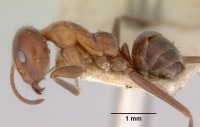Iridomyrmex obscurior
| Iridomyrmex obscurior | |
|---|---|

| |
| Scientific classification | |
| Kingdom: | Animalia |
| Phylum: | Arthropoda |
| Class: | Insecta |
| Order: | Hymenoptera |
| Family: | Formicidae |
| Subfamily: | Dolichoderinae |
| Tribe: | Leptomyrmecini |
| Genus: | Iridomyrmex |
| Species: | I. obscurior |
| Binomial name | |
| Iridomyrmex obscurior Forel, 1902 | |
Label data reveals similar habitat preferences to Iridomyrmex mayri, and, like that ant, I. obscurior will also attend caterpillars of Jalmenus evagoras. This species was discussed by Shattuck (1996), in his revision of the I. discors species-group, but I. obscurior is actually not closely related to I. discors.
Identification
Iridomyrmex obscurior is most similar to Iridomyrmex mayri, but has a shorter antenna. In the field, most workers also lack the pale blue or purple iridescence usually seen in I. mayri. Preserved worker material can also be confused with large workers of Iridomyrmex omalonotus, but there is little if any biogeographical overlap between the two species, and body size together with the structure of the propodeum are determinative. Specimens of Iridomyrmex suchieri (‘Iridomyrmex obscurus’) are also similar, but this is a much smaller ant (HW ≤ 0.95mm) with an antennal scape that does not extend much beyond the head capsule.
Keys including this Species
Distribution
The range of I. obscurior is approximately the same as that of Iridomyrmex mayri, except that the ant does not occur much north of Brisbane, and the original type material was collected at Ballarat, Victoria.
Latitudinal Distribution Pattern
Latitudinal Range: -25.96667° to -38.46666667°.
| North Temperate |
North Subtropical |
Tropical | South Subtropical |
South Temperate |
- Source: AntMaps
Distribution based on Regional Taxon Lists
Australasian Region: Australia (type locality).
Distribution based on AntMaps
Distribution based on AntWeb specimens
Check data from AntWeb
Countries Occupied
| Number of countries occupied by this species based on AntWiki Regional Taxon Lists. In general, fewer countries occupied indicates a narrower range, while more countries indicates a more widespread species. |

|
Estimated Abundance
| Relative abundance based on number of AntMaps records per species (this species within the purple bar). Fewer records (to the left) indicates a less abundant/encountered species while more records (to the right) indicates more abundant/encountered species. |

|
Biology
Castes
Nomenclature
The following information is derived from Barry Bolton's Online Catalogue of the Ants of the World.
- obscurior. Iridomyrmex discors var. obscurior Forel, 1902h: 465 (w.) AUSTRALIA. Raised to species: Shattuck, 1996a: 42. See also: Heterick & Shattuck, 2011: 115.
Type Material
- Syntype, 1 worker, Ballarat, Victoria, Australia, ANIC32-009841, Australian National Insect Collection.
- Syntype, 4 workers, Ballarat, Victoria, Australia, Musee d'Histoire Naturelle Genève.
Description
Worker Description. Head. Posterior margin of head weakly concave; erect setae on posterior margin in full- face view set in a row; sides of head noticeably convex; erect genal setae present on sides of head in full-face view. Ocelli absent; in full-face view, eyes set at about midpoint of head capsule; in profile, eye set anteriad of head capsule; eye semi-circular. Frontal carinae convex; antennal scape surpassing posterior margin of head by approximately 3 x its diameter, or surpassing posterior margin of head by approximately 2 x its diameter. Erect setae on scape present and abundant, or present and sparse; prominence on anteromedial clypeal margin projecting as blunt but distinct protuberance; mandible elongate triangular with oblique basal margin; long, curved setae on venter of head capsule absent. Mesosoma. Pronotum moderately and evenly curved over its length. Erect pronotal setae numerous (12 or more), short and bristly. Mesonotum straight. Erect mesonotal setae numerous (12 or more), short and bristly. Mesothoracic spiracles always inconspicuous; propodeal dorsum smoothly and evenly convex; placement of propodeal spiracle mesad, more than its diameter away from propodeal declivity; propodeal angle weakly present or absent, the confluence of the dorsal and declivitous propodeal faces indicated, if at all, by an undulation. Erect propodeal setae numerous (12 or more), short and bristly. Petiole. Dorsum of node convex; node thin, scale- like, orientation more-or-less vertical. Gaster. Non-marginal erect setae of gaster present on first gastral tergite; marginal erect setae of gaster present on first tergite. General characters. Allometric differences between workers of same nest absent. Colour medium to dark reddish-brown, gaster may be darker than foreparts, iridescence (weak greenish or bluish) confined to gaster. Colour of erect setae white or whitish. In some Victorian specimens mesosoma distinctly lighter than head, while it is only slightly lighter in other Victorian specimens as well as more northern populations.
Measurements. Worker (n = 11)—CI 91–93; EI 22–23; EL 0.25–0.27; EW 0.15–0.16; HL 1.19–1.29; HW 1.10–1.19; ML 0.52–0.57; PpH 0.16–0.18; PpL 0.64–0.68; SI 100–105; SL 1.14–1.19.
References
- Forel, A. 1902j. Fourmis nouvelles d'Australie. Rev. Suisse Zool. 10: 405-548 (page 465, worker described)
- Heterick, B.E. & Shattuck, S.O. 2011. Revision of the ant genus Iridomyrmex (Hymenoptera: Formicidae). Zootaxa 2845: 1-175.
- Shattuck, S. O. 1996a. Revision of the Iridomyrmex discors species-group (Hymenoptera: Formicidae). Aust. J. Entomol. 35: 37-42.
References based on Global Ant Biodiversity Informatics
- Forel A. 1902. Fourmis nouvelles d'Australie. Rev. Suisse Zool. 10: 405-548.
- Heterick B. E., and S. Shattuck. 2011. Revision of the ant genus Iridomyrmex (Hymenoptera: Formicidae). Zootaxa 2845: 1-174.
- Shattuck S. O. 1994. Taxonomic catalog of the ant subfamilies Aneuretinae and Dolichoderinae (Hymenoptera: Formicidae). University of California Publications in Entomology 112: i-xix, 1-241.
- Shattuck S. O. 1996. Revision of the Iridomyrmex discors species-group (Hymenoptera: Formicidae). Australian Journal of Entomology 35 :37-42.

